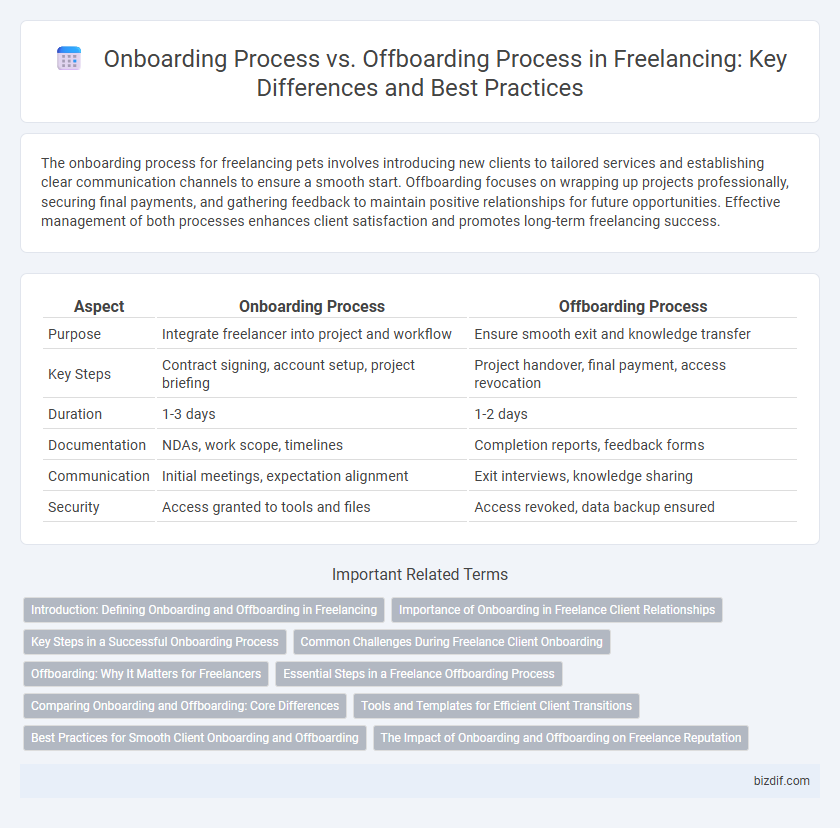The onboarding process for freelancing pets involves introducing new clients to tailored services and establishing clear communication channels to ensure a smooth start. Offboarding focuses on wrapping up projects professionally, securing final payments, and gathering feedback to maintain positive relationships for future opportunities. Effective management of both processes enhances client satisfaction and promotes long-term freelancing success.
Table of Comparison
| Aspect | Onboarding Process | Offboarding Process |
|---|---|---|
| Purpose | Integrate freelancer into project and workflow | Ensure smooth exit and knowledge transfer |
| Key Steps | Contract signing, account setup, project briefing | Project handover, final payment, access revocation |
| Duration | 1-3 days | 1-2 days |
| Documentation | NDAs, work scope, timelines | Completion reports, feedback forms |
| Communication | Initial meetings, expectation alignment | Exit interviews, knowledge sharing |
| Security | Access granted to tools and files | Access revoked, data backup ensured |
Introduction: Defining Onboarding and Offboarding in Freelancing
Onboarding in freelancing refers to the structured process of integrating new clients or projects, ensuring clear communication of expectations, project scope, and deliverables. Offboarding involves the systematic conclusion of a freelance engagement, focusing on knowledge transfer, final deliverables, and feedback collection. Both processes are crucial for maintaining professional relationships and ensuring seamless project transitions.
Importance of Onboarding in Freelance Client Relationships
Establishing a comprehensive onboarding process in freelance client relationships sets clear expectations, enhances communication, and builds trust from the outset, leading to smoother project execution and higher client satisfaction. Effective onboarding facilitates understanding the client's needs, project scope, and deliverables, ensuring alignment and reducing potential misunderstandings. This proactive approach is critical for long-term collaboration and repeat business, making onboarding a foundational element for successful freelancing engagements.
Key Steps in a Successful Onboarding Process
A successful onboarding process in freelancing emphasizes clear communication of project expectations, detailed briefing on tools and workflows, and establishing regular check-ins to ensure alignment. Providing comprehensive access to necessary resources and outlining deliverables upfront ensures freelancers can start work efficiently and meet deadlines. Early integration into team culture and feedback loops enhances productivity and fosters long-term collaboration.
Common Challenges During Freelance Client Onboarding
Freelance client onboarding often faces challenges such as unclear project scopes, misaligned expectations, and inefficient communication channels, which can lead to delays and misunderstandings. Establishing a structured onboarding process with detailed contracts, clear deliverables, and consistent feedback loops helps mitigate these issues. Balancing thorough onboarding while maintaining client engagement is crucial for successful project initiation and long-term collaboration.
Offboarding: Why It Matters for Freelancers
The offboarding process for freelancers ensures a smooth transition by securely transferring project files, finalizing payments, and obtaining client feedback to enhance future work. Proper offboarding protects intellectual property rights and maintains professional relationships, which are crucial for repeat business and positive referrals. Ignoring offboarding can lead to misunderstandings, delayed payments, and reputational damage within the freelancing community.
Essential Steps in a Freelance Offboarding Process
The essential steps in a freelance offboarding process include finalizing all deliverables, obtaining client feedback, and ensuring a smooth transfer of any project documentation or access credentials. Clear communication about project closure timelines and confirming final payments protect the freelancer's reputation and financial interests. Proper offboarding fosters positive client relationships and facilitates potential future collaborations.
Comparing Onboarding and Offboarding: Core Differences
The onboarding process in freelancing focuses on integrating a new contractor by establishing clear communication, setting expectations, and providing necessary resources, while the offboarding process centers on concluding the project, ensuring knowledge transfer, and managing contract closure. Key differences include onboarding's emphasis on relationship-building and alignment with project goals versus offboarding's focus on final deliverables and feedback collection. Efficient management of both processes enhances freelancer satisfaction and project success.
Tools and Templates for Efficient Client Transitions
Effective freelancing relies on streamlined onboarding and offboarding processes utilizing specialized tools and templates to enhance client transitions. Onboarding tools like project management software, contract templates, and client intake forms ensure clarity and set expectations from the start, while offboarding templates for final deliverables, feedback collection, and invoicing secure project closure and client satisfaction. Integrating CRM systems and automated communication workflows further optimizes data management and reduces manual errors during client transitions.
Best Practices for Smooth Client Onboarding and Offboarding
Clear communication and setting expectations from the start are essential for a smooth client onboarding process, including detailed briefs, contracts, and milestone agreements to ensure alignment. During offboarding, providing comprehensive deliverables, final reports, and knowledge transfer facilitates client satisfaction and potential future collaboration. Implementing standardized checklists and feedback loops optimizes both onboarding and offboarding, enhancing overall client experience and project success in freelancing.
The Impact of Onboarding and Offboarding on Freelance Reputation
Effective onboarding enhances a freelancer's reputation by establishing clear expectations, fostering trust, and demonstrating professionalism from the start. A smooth offboarding process ensures positive client relationships, encourages referrals, and protects the freelancer's brand by delivering final deliverables on time and maintaining open communication. Neglecting either phase can result in miscommunications, damaged credibility, and lost future opportunities in the competitive freelance market.
Onboarding Process vs Offboarding Process Infographic

 bizdif.com
bizdif.com